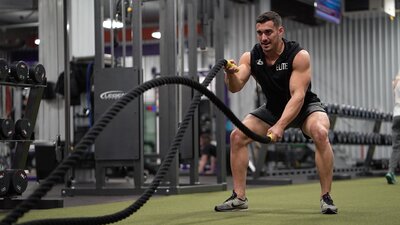During exercise, your body relies on three basic energy systems: the anaerobic a-lactic system, the anaerobic lactic system, and the aerobic system. Depending on the sports played, athletes rely on one system more than the others.
An understanding of the involved energy systems in a particular sport gives valuable information about the strength qualities necessary in that sport. This information gives the personal trainer or strength coach clues on how to conduct the strength training.
The Three Basic Systems
1. Anaerobic A-Lactic (ATP-CP) Energy System
Athletes who compete in sports that require high amounts of short duration acceleration—shot-putters, weightlifters, American football linemen, gymnasts, or sprint-distance speed skaters use the anaerobic a-lactic system. The ALA system does not create energy for sufficient duration to create a great deal of waste products.
2. Anaerobic Lactic (Glycolytic) Energy System
The anaerobic lactic (AL) system (also known as fast glycolysis) provides energy for medium to high intensity bursts of activity that lasts from ten seconds to two minutes. Some American football skill positions, baseball players, soccer players, judokas, middle distance runners (400m-800m) and sprinters rely on this system. The anaerobic lactic system, as well as the ATP-CP system, are capable of high intensity levels, and do not rely on oxygen for fuel.
The primary difference between the two systems is in the capacity of the system. You can think of capacity as the amount of time that the system can work at peak output before dropping off.
Whereas the ATP-CP system will only produce energy for 10 seconds, fast glycolysis works at capacity for as long as two minutes. As a result, waste products such as lactic acid accumulate in the blood and in muscle cells. A burning sensation in the muscle, shortness of breath and fatigue are all symptoms of lactic acid build up.
3. Aerobic Energy System
The aerobic system is the most utilized of the three. It provides energy for low intensity activities that last anywhere from two minutes to a few hours. Unlike the other two systems, the aerobic system requires oxygen and takes much longer to overload. Sports and activities that use continuous sustained efforts such as long distance swimming, crew (rowing) and sea kayaking rely on the aerobic system.
In reality, most sports use a variety of energy systems, or at least the power (time to reach peak output) and the capacity (duration that peak output can be sustained) of the system. The only real exceptions are Olympic weightlifting and certain field events, such as hammer or shot put. Which energy system is most prevalent in a given sport dictates the training intent.
Training Intent
The training intent refers to the athlete's desired outcome from training, whether it is relative strength, hypertrophy, or strength endurance. Every athlete has a training intent that is specific to his or her sport, which is shaped and defined by specific loading parameters.
Relative Strength
Relative strength is defined as strength relative to one's body weight. For example, if a 150-pound person and a 200-pound person both lift 300 pounds in a given lift, the 150-pound person has a higher level of relative strength in that lift.
Relative strength is critical for athletes who use the anaerobic a-lactic system and the anaerobic lactic acid system as their main sources of energy. Maximal strength and limit strength are synonymous with relative strength.
Hypertrophy Strength And Hypertrophy: The Important Difference
Hypertrophy strength—also called functional hypertrophy—is the increased ability to exert force as a direct result of greater functional mass, or muscle tissue. The term hypertrophy refers to the increase in size of muscle cells, as well as to the increase in the number of contractile (muscle) fibers.
Good examples of athletes who benefit from hypertrophy strength training are American football and rugby players. The high-contact nature of their sports demands that they have extra muscle tissue to serve as body armor. Bodybuilding is a sport that relies completely on hypertrophy training.
Hypertrophy relies on the principle of progressive overload, which states that the body adapts and becomes resistant to the same training load over time. In order to grow and make progress, one needs to constantly change the weights, reps, sets and rest period.
It is important to understand that hypertrophy occurs, to some degree, at all levels of resistance training, but, the amount of hypertrophy an individual experiences at any intensity bracket is a function of their genetic predisposition and fiber type.
Therefore, the greatest amounts of hypertrophy do not occur in the same intensity bracket that the greatest increases in strength, or the greatest increases in endurance, occur. This factor, and the ability to manipulate it to athletic advantage, is the most important concept in strength coaching today.

The greatest amounts of hypertrophy don't occur in the same intensity bracket as the greatest increases in strength.
Hypertrophy strength is a function of the anaerobic lactic acid energy system.
Strength Endurance
Endurance athletes, such as marathon runners and rowers, are required to overcome a relatively low resistance for a prolonged period of time. The aerobic system is an efficient energy system that relies on oxygen for fuel. In reference to weight training, strength endurance is the ability to produce repeated muscular contractions with less than maximal weight-typically at loads below 75% of 1RM.
There is great variation in the loading parameters for relative strength, hypertrophy and strength endurance. The loading parameters chosen should improve the strength of the involved energy system of the athlete, thus producing an athlete who is in shape for their sport.
Loading Parameters—Functional Definitions
Reps
Reps are short for repetitions, or the number of times that a movement is repeated at one time. For instance, a set of 10 push-ups equates to ten reps in the push-up.
The number of repetitions performed during a specific set of a workout determines the training effect. Neurological efficiency is achieved through training in the lower rep range and metabolic (muscular) adaptations are achieved through training with higher repetitions. The number of reps dictates all other aspects of strength training, namely the sets, the tempo and the rest period.
After the initial assessment of an athlete/client, the qualified personal trainer will prescribe a repetition range based on the needs and goals of the client. For novice lifters, higher reps (12-20) and lighter loads are prescribed to teach the body new exercise movement patterns.
Sets
Sets describe a group of repetitions. For example, 3 sets of 10 reps in the pushup equates to three individual efforts of ten repetitions each. There is an inverse relationship between the number of sets and the number of reps in any given workout; the higher the number of reps, the lower the number of sets necessary to elicit the appropriate training response. Lower numbers of reps require higher numbers of sets.
For a beginner, 2-3 sets of 12-20 repetitions should be sufficient to teach the body how to move through different planes of movement. After the first 4-6 weeks, depending on the learning curve of the client, the personal trainer or strength coach should increase the number of sets of the workout. The client should then perform multiple sets of the prescribed exercise if strength is a major goal.
Time Under Tension
Time under tension (TUT) is the amount of time that a muscle or muscle group is put under stress during a single rep, set, or workout.
For example, if a client performs a biceps curl and lifts the weight in 1 second and lowers it in 4, the time under tension for that repetition is 5 seconds. In this particular example, the TUT would be noted as 4010, where 4 seconds is the time it takes to eccentrically lower the weight, 0 seconds is the time of pause at the bottom position of the curl, 1 second is the time it takes to concentrically lift the weight and the last 0 seconds is the pause at the top of the movement.
Time under tension is inversely proportional to both reps and sets. The more time that stress is placed on a muscle in one rep, the less reps and sets are necessary to produce the same training effect.
Rest Intervals
- Training goal
- Training intensity
- Fitness level of the client
Training Goal, Training Intensity And Rest Period
The training goal is, simply, the desired training effect. It is closely related to the training intensity, in that the goal dictates the intensity, which in turn dictates the rest period.
The training intensity can be described as the percentage of 1RM, or repetition maximum, that one exercises at. The more intense the workout, the higher the percentage of 1RM that one works and the longer the corresponding rest period must be in order for the central nervous system to recover.
There exists a great deal of misunderstanding in the fitness industry about intensity, which is a word typically used to describe workouts that are hard. A workout can be difficult without being intense—circuit weight training is difficult and taxing to the body, but it is not intense, by the strict definition of the word.
Lastly, the fitness level of the client cannot be overlooked when assigning inter-set rest intervals. An untrained individual needs more recovery time than an experienced lifter. Conversely, an experienced trainee can be made more advanced once he has reached his appropriate level of strength by progressively reducing his rest period, so that he produces the same amount of work in less time.

